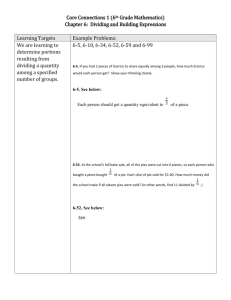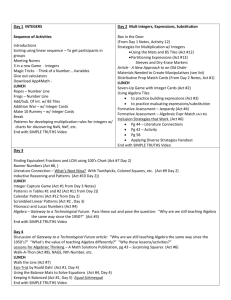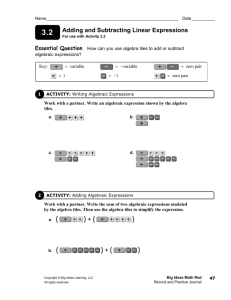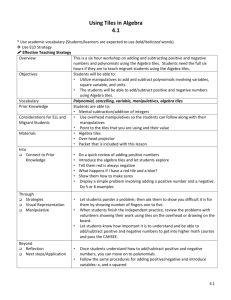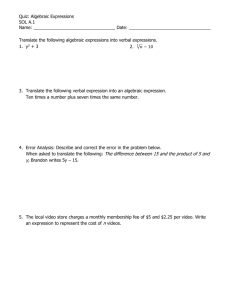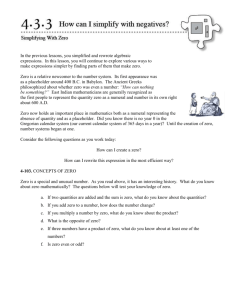Algebra_Tiles_Addition_(S)
advertisement
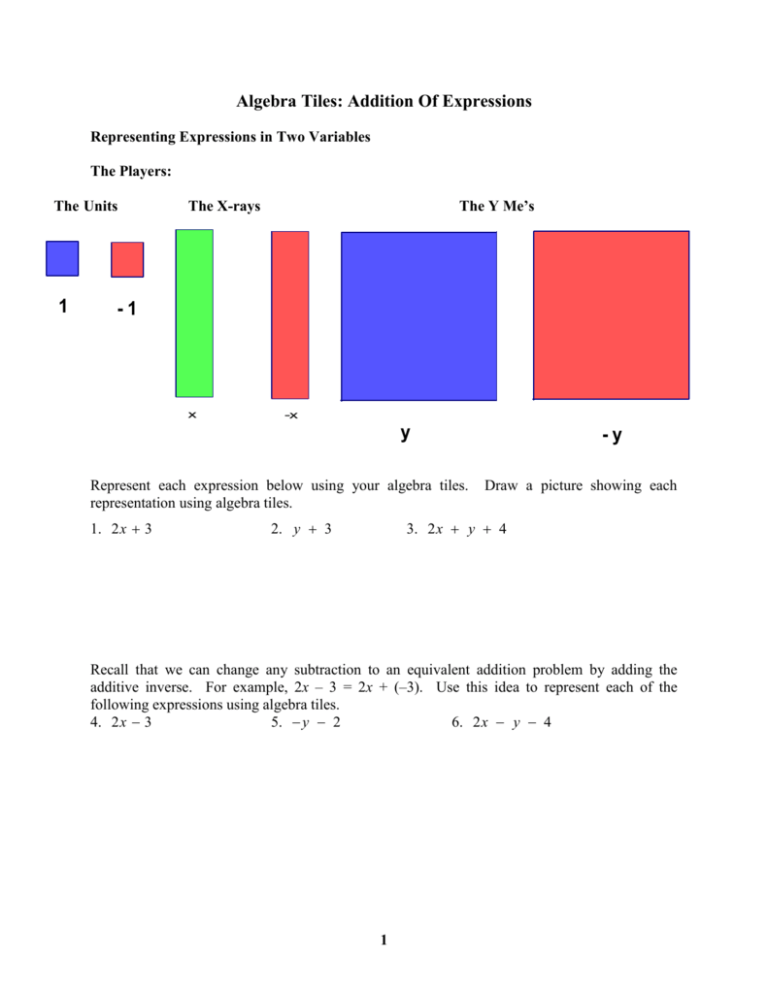
Algebra Tiles: Addition Of Expressions Representing Expressions in Two Variables The Players: The Units 1 The Y Me’s The X-rays -1 x -x y Represent each expression below using your algebra tiles. representation using algebra tiles. 1. 2 x 3 2. y 3 -y Draw a picture showing each 3. 2 x y 4 Recall that we can change any subtraction to an equivalent addition problem by adding the additive inverse. For example, 2x – 3 = 2x + (–3). Use this idea to represent each of the following expressions using algebra tiles. 4. 2 x 3 5. y 2 6. 2 x y 4 1 Extending the Zero Principle to Variable Expressions 7. We saw previously that 3 3 0 . Create two different groups of algebra tiles each with a value of zero. Use rectangles (x’s) for the one group and large squares (y’s) for the other. Draw each different representation of zero in the space below. Below each drawing show an expression using algebraic notation indicating what was added to get 0. 8. We say 3 and 3 are additive inverses because their sum is 0. What is the additive inverse of 5 ? Why? 9. What is the additive inverse of 3x – 4? How do you know you are correct? 10. What is the additive inverse of the expression y 3 x 1 ? How do you know that these two expressions are additive inverses? 11. State in your own words how to alter a set of algebra tiles representing an algebraic expression to find the additive inverse of the polynomial. 2 Addition of Algebraic Expressions In terms of their algebra tile representations the sum of two algebraic expressions is interpreted as the union (combination) of the two sets of algebra tiles representing the two polynomials. We then use the zero principle to reduce the number of tiles needed to represent the sum. Example: Simplify 2x y 4 3x y 2 . Solution: We represent each expression using algebra tiles. 2x y 4 3x y 2 We now group like terms and find combinations that make 0. Two green rectangles (2x) plus two red rectangles (2 x) equals 0, so the value is 0 ( x) x . = Next, one red large square ( y ) plus one blue large square (y) equals 0. 3 Finally, we combine the constants. Four small red squares (4) plus two small yellow squares (2) can be regrouped as two small red squares plus 2 small yellow squares which equals 0 plus 2 small red squares. That is, 4 2 2 (2 2) 2 0 2 . = Therefore, 2x y 4 3x y 2 = x 0 (2) x 2 . For questions 12 and 13, a) represent each sum problem using algebra tiles, b) draw a picture of the algebra tiles for each sum, and c) write an algebraic expression for each sum. 12. (2 x 5) (3x 1) 13. (2 x y 4) ( x 3 y 2) 4 Representing Expressions in One Variable We can use the same algebra tiles to represent expressions in one variable. The small squares will still represent constants since they have area 1 square centimeter and the rectangles will still represent terms involving x since they are 1 unit by x units and have area x. However, the large squares are x units by x units or x x square units. The large blue square is our representation for x 2 . The large red square represents x 2 . 1 -1 x -x x 2 -x 2 For questions 14 – 16 represent each expression below using your algebra tiles. Draw a picture showing each representation using algebra tiles. You can use shading to indicate a negative (red) tile. 14. 2 x 3 15. x 2 3 16. 2 x 2 x 4 5 Recall that we can change any subtraction to an equivalent addition problem by adding the additive inverse. For example, 2 x 2 x 4 = 2 x 2 ( x) 4 . Use this idea to represent each of the following expressions using algebra tiles. 17. 2 x 3 18. x 2 2 19. 2 x 2 x 4 6 Extending the Zero Principle to Expressions in One Variable 20. Draw a representation of zero using the large squares (terms involving x 2 ) in the space below. Show an expression using algebraic notation indicating what was added to get 0. 21. We say that 3x 2 and 3x 2 are additive inverses of each other, since 3x 2 3x 2 0 . What is the additive inverse of the expression x 2 3x 1 ? How do you know that these two expressions are additive inverses? 22. What is the additive inverse of 7 5x 6 x 2 ? Prove that they are additive inverses of each other. 23. State in your own words how to alter a set of algebra tiles representing an algebraic expression to find the additive inverse of the expression. 7 Addition of Algebraic Expressions In terms of their algebra tile representations the sum of two algebraic expressions is interpreted as the union (combination) of the two sets of algebra tiles representing the two expressions. We then use the zero principle to reduce the number of tiles needed to represent the sum. (For example, two positive (green) x tiles cancel out two negative (red) x tiles and 3 positive (blue) x 2 tiles cancel out 3 negative (red) x 2 tiles.) For questions 24 and 25 a) represent each sum problem using algebra tiles, b) draw a picture of the algebra tiles for each sum, c) use representations of zero to reduce the number of tiles needed, d) write an algebraic expression for the remaining tiles, and e) use the additive identity principle to write the sum in simplest terms. Remember to change any subtraction to adding the additive inverse. 24. x 2 4 x 6 3x 4 25. (2 x 2 x 4) ( x 2 3x 2) End of Project 8

